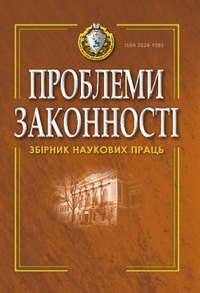Principle of Separation of State Power under Constitution of Pylyp Orlyk of 1710 and Polish Constitution of 1791
DOI:
https://doi.org/10.21564/2414-990x.144.154647Keywords:
Constitution of Pylyp Orlyk, government body, separation of powers, legislature, executive power, judiciaryAbstract
The article analyzes the supreme bodies of state power under the Constitution of Pylyp Orlyk of 1710 and the Constitution of Poland of 1791 concerning the application of the principle of separation of state power into legislative, executive and judicial braches. The principle of separation of state power was introduced in these constitutions which were based on the own state and legal experience and ideas of the Western European political and legal thought of the Age of Enlightenment. In practice of the European constitutionalism, the Constitution of Pylyp Orlik of 1710 was the first attempt to adopt a constitution providing separation of state power into three branches (legislative, executive and judicial) as well as a system of checks and balances. Introducing the state power mechanism was aimed at the attempts of Cossack officers to increase the efficiency of state power and prevent usurpation of power by both a hetman and particular groups of Cossack officers.
The Polish Constitution of 1791 was based on the idea of rule of the people, which is the only source of power, and the idea of separation of state power into three branches: legislative, executive and judicial. The legislature – the Seim, the executive power – the King and Government and the judiciary – local and higher courts are autonomous towards each other. None of the public powers could assign another body’s authorities. The mechanism of the system of checks and balances operated through parliamentary bicameralism, the Government formation by the King and Seim, participation of the King in the Government, the Seim deputies did not have the right to hold positions in executive bodies, different terms of authorities of the legislative, executive and judicial bodies. Such a mechanism was intended to prevent the usurpation of power by a single body or person and, most importantly, to improve the effectiveness of the state mechanism in order to withdraw the country from the political crisis and strengthen the Polish statehood.
Constituting the separation of state power in the Ukrainian and Polish Constitutions of the eighteenth century was aimed at improving the state mechanism, preventing the possibility of usurpation of power within the country, increasing the effectiveness of the state mechanism in order to withdraw the country from the political crisis.
References
Miroshnichenko, M.I., Miroshnichenko, V.I. (2001). Istoria vchen pro derzhavu i pravo. Kyiv: Atika [in Ukrainian].
Matiah, V.M. (2011). Getman v emigracij Pylyp Orlyk: istoryko-istoriografichnyj portret pol-ityka. Ukrainskij istorichnyj zhurnal – Ukrainian historical journal, 4, 116–131 [in Ukrainian].
Kresin, O.V. (2005). Pakty j konstytucij zakoniv i volnostej Zaporozkogo Vijska 1710 r. Ukrainskij istorichnyj zhurnal – Ukrainian historical journal, 2, 192–204 [in Ukrainian].
Istoria konstytucijnogo zakonodavstva Ukrajny: zb. dok. V.D. Goncharenko (Ed.). (2007). Kharkiv: Pravo [in Ukrainian].
Javornyckyj, D.I. (1991). Istoria zaporozkih kozakiv. P.S. Sohan (Ed.). (Vols. 1–3); Vol. 3.Kyiv: Nauk. dumka [in Ukrainian].
Todyka, U.M. (2006). Polityko-pravove znachenia Konstytucij Pylypa Orlyka dla roz-vytku ukrajnskogo konstytucionalizmu. Derzhavne budivnyctvo ta misceve samovraduvannia – State building and local self-government, issue 11, 3–9 [in Ukrainian].
Bedrij, R.B. (2008). Rozpodil vlad za Konstytucieu Pylypa Orlyka. Naukovyj visnyk Lvivskogo derzhavnogo universytetu vnutrishnih sprav – Scientific announcer of the Lviv state university of internal affairs, issue 3, 1–6 [in Ukrainian].
Tyszhyk, B.J. (2006). Do pytania pro rozrobku, pryjniattia ta sut pershoj konstytucij Polszhi vid 3 travnia 1791 roku. Visnyk Lvivskogo universytetu – Announcer of the Lviv university, 42, 103–115 [in Ukrainian].
Konstytucja 3 maja 1791. (1991). Statut zgromadzenia przyjaciol Konstytucji. Opracowal Jerzy Kowecki. Warszawa: Panstwowe Wydawnictwo Naukowe [in Poland].
Kovalski, E.S. (2016). Zapozhdenie evropejskogo i polskogo konstytucionalizma v ХVІІІ veke. Vserossijskij nauchno-prakticheskij zhurnal «Usticia» – An all-russian research and practice journal is «Justice», 1, 1–12 [in Russian].
Downloads
Published
How to Cite
Issue
Section
License
Copyright (c) 2019 Анатолій Іванович Козаченко

This work is licensed under a Creative Commons Attribution 4.0 International License.










